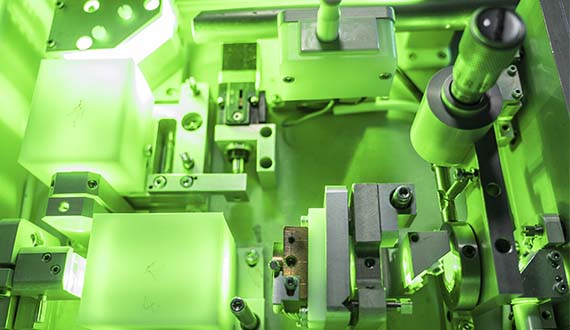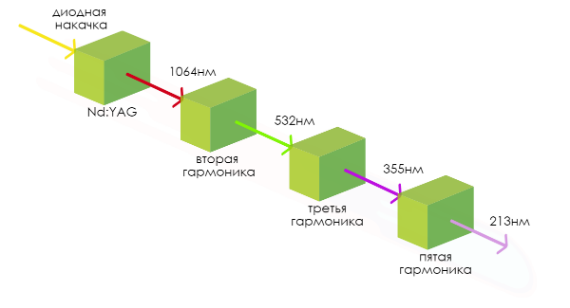Solid state technology
A solid state nanosecond pulsed Nd:YAG laser is used for performing refractive operations with the use of solid state technology. Infrared radiation with the wavelength of λ=1064 nm is generated by optical pumping of an yttrium aluminum garnet doped with neodymium. The working ultraviolet radiation with the wavelength of λ=213 nm is formed by cascade transformation with the use of three nonlinear crystals (scheme).
Clinical benefits of the solid state technology are first of all due to the physical properties of UV radiation with the wavelength (λ) of 213 nm. It has been found that the water, physiological saline, balanced salt solution have lower absorption coefficients and greater penetration depth for the radiation with λ=213 nm (compared to λ=193 nm). Besides, radiation with the wavelength of λ=213 nm is close to the maximum of corneal collagen absorption. Combination of the above factors ensures a high tolerance of this type of radiation to the degree of cornea hydration and the presence of a layer of liquid on its surface, as well as lower sensitivity of laser radiation to humidity and temperature in the surgery room. All this allows ablating the corneal stroma in its most adjusted to human physiology condition, thus forming uniform and smooth surfaces. It should also be noted that the small size of the spot in combination with high generation frequency and low pulse energy ensures precise ablation with less energy and heat load on corneal stroma.
Operating benefits of the solid state technology are due to the design of the laser emitter itself. This technology does not require costly maintenance for prolonged, high-quality and smooth operation of the laser emitter. Besides, operating solid state units frees the user from the issues associated with purchase, storage, maintenance, replacement and disposal of gas mixtures containing fluoride, which is corrosive to laser components and toxic. And the only disposable element in the maintenance of the unit is the distilled water in the cooling system. Compact dimensions of the solid-state emitter can significantly reduce the size and the weight of the refractive installation, and modular design ensures its mobility.

Safety
Numerous researches of domestic and foreign scientists have shown that UV radiation up to 230 nm is completely absorbed by the cornea without penetrating into the inner parts of the eye. Moreover, the minimum damaging (including heat) effect of the 213 nm wavelength radiation on the cornea has been noted, similar to the effect of 193 nm wavelength radiation, and the absence of carcinogenic and mutagenic effects on the eye tissues.
Numerous researches of domestic and foreign scientists have shown that UV radiation up to 230 nm is completely absorbed by the cornea without penetrating into the inner parts of the eye. Moreover, the minimum damaging (including heat) effect of the 213 nm wavelength radiation on the cornea has been noted, similar to the effect of 193 nm wavelength radiation, and the absence of carcinogenic and mutagenic effects on the eye tissues.


